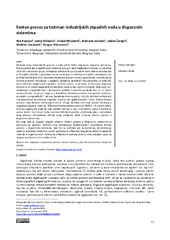Приказ основних података о документу
Fenton process in dispersed systems for industrial wastewater treatment
| dc.creator | Popović, Ana | |
| dc.creator | Milicević, Sonja | |
| dc.creator | Milosević, Vladan | |
| dc.creator | Ivošević, Branislav | |
| dc.creator | Carapić, Jelena | |
| dc.creator | Jovanović, Vladimir | |
| dc.creator | Povrenović, Dragan | |
| dc.date.accessioned | 2021-03-10T14:00:38Z | |
| dc.date.available | 2021-03-10T14:00:38Z | |
| dc.date.issued | 2019 | |
| dc.identifier.issn | 0367-598X | |
| dc.identifier.uri | http://TechnoRep.tmf.bg.ac.rs/handle/123456789/4154 | |
| dc.description.abstract | Industrial wastewater contains recalcitrant organic compounds with a very complex chemical structure, built of molecules with long chains of carbon atoms and attached different functional groups. Chemical or biological treatments used for removal of these compounds are being replaced with more efficient non-commercial wastewater treatments. Advanced oxidation processes overcome limitations of conventional methods regarding formation of by-products during degradation of recalcitrant organic compounds. The Fenton process, or use of the Fenton's reagent, has became one of the most utilized processes due to simplicity, economy and accessible amounts of ferrous iron and hydrogen-peroxide, which are used in the process. In specific, the Fenton's reagent is a catalytic-oxidative mixture of these two components. The ferrous iron Fe2+ initiates and catalyzes decomposition of H2O2, resulting in generation of hydroxyl radicals, which are the main radical species in the process able to detoxify several organic pollutants by oxidation. In addition, other mechanisms besides formation of hydroxyl radicals may occur during the Fenton process and participate in degradation of target pollutants. Generally, the treatment efficiency relies upon the physical and chemical properties of target pollutants and the process operating conditions. The main disadvantage of the Fenton process is production of sludge formed by iron hydroxide at certain pH values. An alternative solution for this problem is application of this process in fluidized bed reactors. This paper presents an overview of Fenton and photo-Fenton processes in dispersed systems for removal of different industrial wastewater pollutants. The most important process parameters, required for efficient degradation of recalcitrant organic compounds are also described, such as the catalyst type, pH value, temperature, H2O2 concentration and retention time. Strict control of Fenton process parameters in fluidized bed reactors at desired values can bring these systems to the commercial use. | en |
| dc.publisher | Savez hemijskih inženjera, Beograd | |
| dc.relation | info:eu-repo/grantAgreement/MESTD/Technological Development (TD or TR)/33007/RS// | |
| dc.rights | openAccess | |
| dc.rights.uri | https://creativecommons.org/licenses/by-nc-nd/4.0/ | |
| dc.source | Hemijska industrija | |
| dc.subject | advanced oxidation processes | en |
| dc.subject | Fenton process | en |
| dc.subject | photo-Fenton process | en |
| dc.subject | fluidized bed reactors | en |
| dc.title | Fenton process in dispersed systems for industrial wastewater treatment | en |
| dc.type | article | |
| dc.rights.license | BY-NC-ND | |
| dc.citation.epage | 62 | |
| dc.citation.issue | 1 | |
| dc.citation.other | 73(1): 47-62 | |
| dc.citation.rank | M23 | |
| dc.citation.spage | 47 | |
| dc.citation.volume | 73 | |
| dc.identifier.doi | 10.2298/HEMIND181019005P | |
| dc.identifier.fulltext | http://TechnoRep.tmf.bg.ac.rs/bitstream/id/9388/0367-598X1900005P.pdf | |
| dc.identifier.scopus | 2-s2.0-85064486787 | |
| dc.identifier.wos | 000460129400005 | |
| dc.type.version | publishedVersion |

